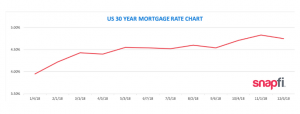
For the last several years, the housing market has been driven by more buyers than sellers. The combination of steady economic growth and historically low interest rates on new mortgage loans created an environment known as a seller’s market. This means that homes are moving from listed to sold in a short period of time, often with several offers, especially in high-demand neighborhoods.
However, new economic and market data indicates a shift toward buyers. Several factors are influencing the potential for a buyer’s market in the near future, including rising interest rates, increased inventory, and flattening home prices across the country. Both home buyers and sellers should recognize these trends and take note of what it could mean for them.
A Focus on Rates
One of the leading factors in determining the affordability of homeownership is the interest rate on a new home loan. Mortgage rates have been depressed for the better part of a decade, as the Fed used its monetary powers to keep a proverbial lid on long-term interest rates to help prop up the economy. That strategy worked, at least in theory, to encourage prospective homeowners to purchase real estate before interest rates crept back up. We are coming out of that season now, highlighted by the reality of rising rates.
Over 2018 alone, the Fed increased interest rates three times, with a fourth rise on the docket. Throughout 2019, there is an expectation that interest rate hikes will continue. While rising rates point to a strong economic environment, the strategy can have a different impact on the housing market overall. Homebuyers are less inclined to buy a home when the total cost of borrowing is higher.
As this trend continues, sellers are starting to see the end result: homes remain listed for longer than anticipated which leads to price cuts to entice ready and willing buyers. In high-demand areas, like San Diego, 20% of homes for sale experienced a price cut, up from the 12% reported in 2017.
The relationship between homebuyers and rising rates is a complex one, but the rate environment we are currently experiencing has the potential to tip the scales toward buyers in the next two years.
Inventory and Demand
Another factor driving the shift toward a buyer’s market is the slow but noticeable change in inventory and the correlation to buyer demand. Since the housing market low a decade ago, hundreds of thousands of home lost to foreclosure have been scooped up by investors. These properties were then turned into rentals, not sales, creating a low housing inventory.
Similarly, homebuilders did not rise to the occasion, seemingly falling behind the demand for new homes, as younger generations matured into their home-buying years. The combination of these issues set the stage for a shortage of homes, allowing available homes to skyrocket in terms of price.
State and local governments did not help either: municipalities have made zoning decisions that makes it difficult and/or expensive for builders to build new homes at scale. This results on higher cost for builders that ultimately gets passed on to the homebuyer.
Fortunately, the current environment is showing signs of slowing down as it relates to home prices. Zillow’s most recent report highlights the fact that while home values rose 8.3% over the past year, the projected growth over the next year is 6.6%. Additionally, the Census Bureau reports that housing starts are on the rise, although ever so slightly.
As home values grow at a slower rate and more inventory becomes available, sellers have less of an upper hand in the market. Buyers, alternatively, are less likely to face bidding wars and the need to increase their offers to get the home of their dreams. Instead, they can wait out their purchase for the home they want, creating a buyer’s market.
A Buyers Market by 2020?
The housing market data coming in this year and projected for 2019 show a nod toward buyers, but the timing of a full shift is not yet known. Some predict a buyer’s market will be in effect starting as early as late 2019, likely encompassing the Midwest first, and trickling out to major metropolitan areas in the beginning of 2020. The growing number of price cuts, increased interest rates, increasing days on market, and growing inventory all point to the end of the sellers’ reign.
However, homebuyers still need to be diligent about making their home-buying decisions. The plan to purchase a home, whether in a buyer’s or seller’s market, must be based on affordability factors, plans for both and short- and long-term, and an understanding of how a home may add to one’s overall financial picture.
Home buying is still the most effective and fool proof way of creating long term wealth. Let us help you invest in your future.



